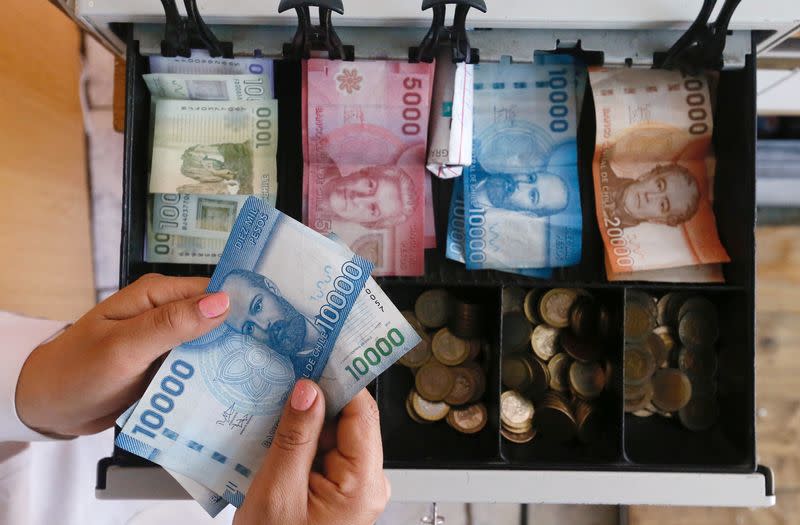Analysis-Chile's sliding peso reflects tough battle vs rampaging dollar

By Alexander Villegas and Natalia A. Ramos Miranda
SANTIAGO (Reuters) - Chile's sliding peso got a shot in the arm in July from a huge $25 billion central bank intervention, but in recent months has been one of the region's worst performers, showing how hard the battle is for policy makers countering a rampaging dollar.
The Chilean currency is threatening to breach the 1,000 peso per dollar line once again after it hit a record low near 1,050 pesos in July. That milestone led the central bank to launch a plan to sell $20 billion in dollars and FX hedging instruments, backed up by a $5 billion currency swap and peso liquidity program.
That move successfully helped cull wild volatility.
However, as the U.S. dollar soars and interest rate hikes by the U.S. Federal Reserve hammer global currencies from the British sterling to the Japanese yen and Chinese yuan, the impact of Chile's intervention has faded.
In the last two months the currency has weakened some 6.5% versus the dollar, trailing major regional currencies in Brazil, Mexico, Peru and Colombia. It is likely to weaken more after the central bank ended its intervention program on Sept. 30.
(GRAPHIC: Latam currencies vs the dollar - https://graphics.reuters.com/CHILE-CURRENCY/klpykxdlbpg/chart.png)
"Probably in the short term, maybe in October we'll see 1,000 pesos (to the dollar) and maybe we'll beat our historic low," said Angel Rubilar, a Santiago-based senior analyst at Libertex. The currency is now worth 968 per dollar.
Chile is not alone in having to defend its currency. FX interventions have increased in India, the Philippines and Korea in recent weeks, while Japan's central bank spent a record 2.8 trillion yen ($19.7 billion) in the FX market last week.
That intervention, following the yen's slump to a 24-year low of nearly 146 to the dollar, triggered a sharp bounce of more than 5 yen per dollar, although the currency has drifted down again to around 144.7.
(GRAPHIC: Chilean peso - https://graphics.reuters.com/CHILE-CURRENCY/egvbkzawlpq/chart.png)
'RESERVES AREN'T INFINITE'
Diego Mora, a market strategist for XTB Latam, said that Chile's central bank intervention had helped reduce the chances of aggressive currency moves, but had its limits.
"The intervention was successful for what the central bank needed, which was controlling volatility in the exchange rate, but not the price," said Mora, noting that markets were already pricing in the end of the intervention next week.
"The possibility of a sharp crash is lower."
Chile, the world's top producer of copper and the No. 2 for electric vehicle battery metal lithium, is also grappling with annual inflation at some 14%, weakening copper prices and a predicted recession, compounding the hit from the strong dollar.
Currency strategist Juan Prada at Barclays said the tightening of global financial conditions was ramping up pressure on some regional markets particularly susceptible to external global economic impacts.
"We have identified Chile and Colombia as vulnerable, and COP (Colombian peso) and CLP (Chilean peso) have underperformed LatAm peers" since the U.S. Federal Open Market Committee meeting in September, he said.
Chile's central bank, however, has given no indication that it would intervene again. Analysts and traders say that despite pressures, another intervention would be "hasty" and could risk longer-term stability by denting levels of reserves.
"Reserves aren't infinite," Mora added. "If the central bank has less direct reserves of foreign currency, the country becomes riskier with its long-term interest rates."
(Reporting by Alexander Villegas and Natalia Ramos; Additional reporting by Karin Strohecker in London; Editing by Adam Jourdan and Richard Chang)

 Yahoo Movies
Yahoo Movies 